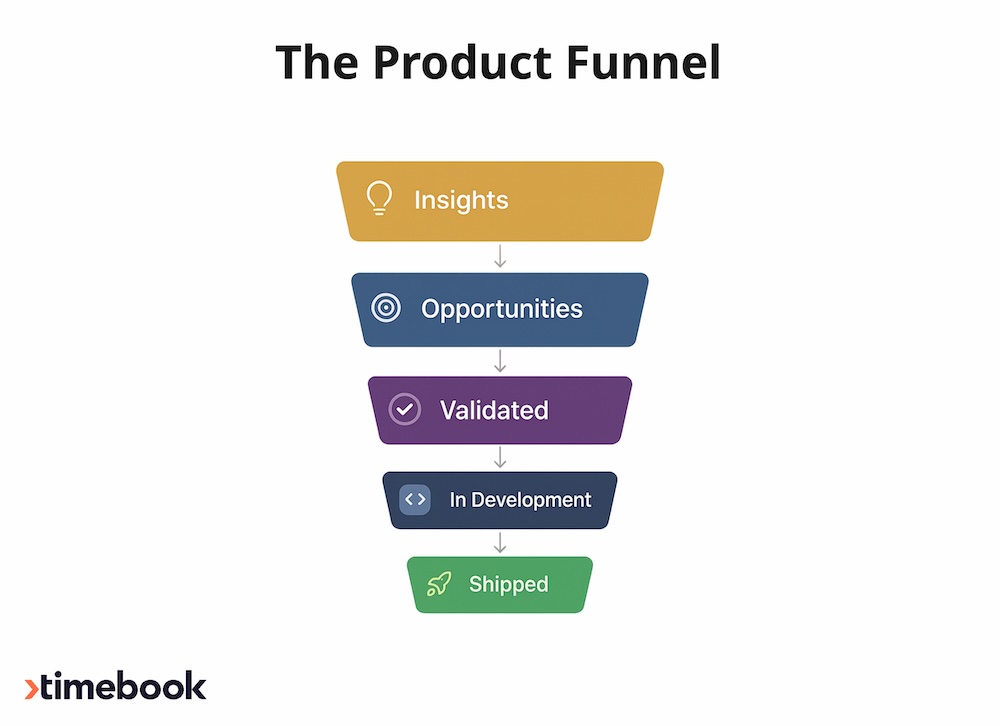Ditch the backlog and use a product funnel to qualify, build, and deliver what truly matters.
Joe Fields
Most product teams are drowning in feature requests. The backlog grows endlessly, an unordered list of ideas, demands, and “must-haves” from every corner of the business. There’s no qualification, no progression, and no clear way to say “no.” Just a pile of things to build. But what if product teams managed their work like sales teams manage leads?
Sales doesn’t treat every inbound contact as a deal. They qualify, prioritize, and track conversion rates through a funnel, from initial interest to closed revenue. Product teams should do the same. That’s where the Product Funnel comes in.

The image above captures the essence of this shift. Instead of a flat backlog, we see a funnel, narrowing from broad customer input to focused delivery. Each stage filters and qualifies the work, ensuring only the most valuable ideas make it through.
Let’s walk through each stage.
At the top of the funnel are raw insights, customer conversations, support tickets, sales feedback, analytics, and market signals. This is the lead pool. It’s noisy, unstructured, and full of potential.
The goal here isn’t to act on every comment. It’s to listen systematically and capture what customers are really saying. At this stage, quantity matters more than precision. You’re building the foundation.
From those insights, product teams extract real problems worth solving. These are the qualified opportunities, validated pain points, unmet needs, and recurring themes that align with strategic goals.
Just like sales qualifies leads, product qualifies ideas. Not every insight becomes an opportunity. The ones that do are backed by evidence, aligned with business outcomes, and worth exploring further.
Once an opportunity is qualified, the team explores how to solve it. This is the validation stage, where multiple solutions are considered, tested, and compared. It’s not about jumping to the first idea. It’s about understanding the problem deeply and choosing the best path forward.
This stage is often underrepresented in traditional backlogs. But it’s critical. Without it, teams risk building features that don’t solve real problems.
Only after validation does the team move into development. At this point, the solution has been vetted, the opportunity is clear, and the feature is ready to be built.
This stage should be lean and focused. Because the work has already been qualified and validated, development becomes execution, not exploration.
At the bottom of the funnel is the outcome. The feature is live. But the work isn’t done. Now the team must ask: Did it work? Did it solve the problem? Did it move the metrics?
This is where product teams often fall short. They measure success by output, features shipped, rather than outcomes delivered. The funnel flips that logic. It starts with the problem and ends with the impact.
The visual funnel isn’t just a diagram, it’s a mindset shift. It reframes product work from reactive delivery to strategic problem-solving. It introduces qualification, progression, and measurement. And it aligns product with the language and logic of the business.
Here’s what changes:
Feature factories jump straight from insight to development. They skip qualification, validation, and measurement. It’s like a sales team trying to close every lead without discovery.
Thought leaders like Teresa Torres, Marty Cagan, and Josh Seiden have long warned against this trap. Torres emphasizes the importance of discovering opportunities, not just solutions. Cagan critiques teams that measure progress by output instead of outcome. Seiden defines success as a change in human behavior that drives business results.
The Product Funnel operationalizes these principles. It forces teams to ask: Is this the most important problem to solve right now? What are the possible ways to solve it? And did our solution actually work?
Timebook helps teams manage this funnel end-to-end. It starts by capturing insights from all sources, support, sales, interviews, analytics. Then it helps qualify those insights into opportunities, assess them for strategic fit, and explore multiple solutions.
From there, teams move into development with confidence. And once features ship, Timebook.ai tracks whether they delivered value, whether they solved the problem and moved the metrics.
This approach transforms product teams from feature order-takers into strategic problem solvers. It aligns product work with business goals, reduces wasted cycles, and builds confidence in what to build next.
Sales converts leads into revenue. Product should convert customer insights into value. That’s the promise of the Product Funnel.
By adopting this mindset, and using tools like Timebook, product teams can escape the backlog trap, align with strategy, and deliver outcomes that matter.
Because building the right thing is just as important as selling to the right customer.